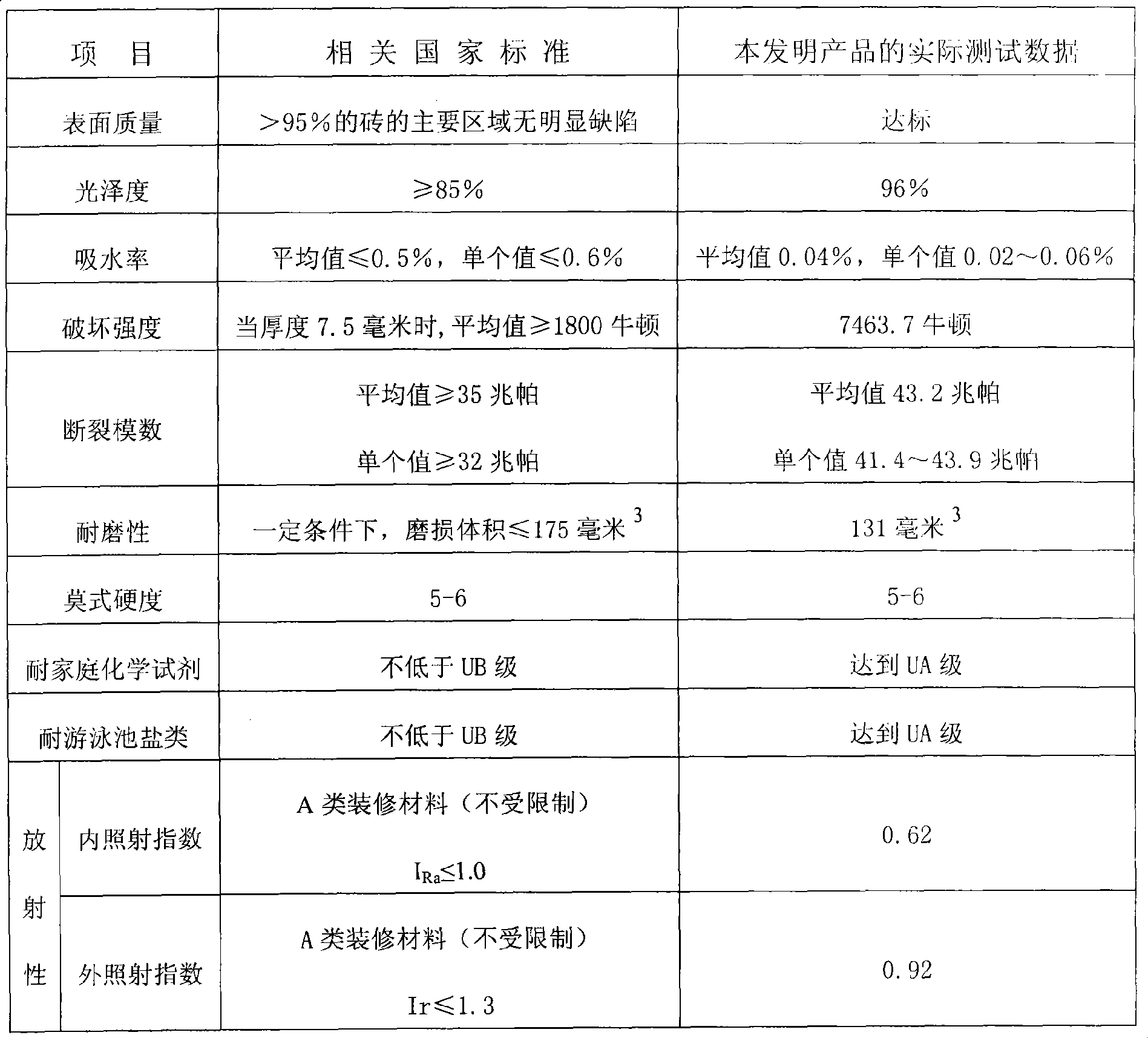Method for producing microcrystalline glass-ceramics composite board with novel microcrystalline phase
A glass-ceramic and glass-ceramic technology, which is applied in the field of building materials, can solve the problems of monotonous particle collection style, affecting competitiveness and sales, and unfavorable promotion of high-grade composite plates, etc., and achieves the effect of wide distribution and low price.
- Summary
- Abstract
- Description
- Claims
- Application Information
AI Technical Summary
Problems solved by technology
Method used
Image
Examples
Embodiment 1
[0014] The preparation method of microcrystalline ceramic composite plate of the present invention, at first prepares microcrystalline glass, is SiO by component weight 2 57.20%, Al 2 o 3 10.62%, Na 2 O+K 2 O 3.3%, Li 2 O 0.67%, BaO 6.35%, B 2 o 3 5.3%, CaO 9.93%, MgO 6.62%, select the corresponding proportion of less than 100 mesh quartz, lithium feldspar, barium carbonate, alumina, boric acid, soda ash, dolomite, talc, calcite, and add an appropriate amount of clarifying agent, Crystal nucleating agent, batching, mixed in the mixer for 30 minutes, at 8 meters 2 The melting temperature is 1490°C, and the storage time is 20 hours. The clarified melt is water quenched, dried, sieved, broken, and sieved again to obtain 8-20 mesh glass-ceramic pellets. use;
[0015] Then prepare ceramic green slabs, press SiO 2 70.92%, Al 2 o 3 18.06%, CaO 0.09%, MgO 0.21%, K 2 O 3.24%, Na 2 O 2.03%, Fe 2 o 3 0.56%, TiO 2 0.19% component weight ratio, burning vector 4.70%, s...
Embodiment 2、3、4
[0018] Present embodiment 2,3,4 is carried out by each step of embodiment 1, repeats no more, but has following difference with example 1:
[0019] ① In Example 2, the glass-ceramic composition needs to be added with 1.2% MnO 2 ;
[0020] In Example 3, the glass-ceramic composition needs to add 0.15% Fe 2 o 3 , 1.6% CeO 2 , 0.7% MnO 2 ;
[0021] In Example 4, the glass-ceramic composition needs to add 0.12% MnO 2 , 0.06% NiO, 0.024% Co 2 o 3 (+Co 3 o 4 ).
[0022] ②The firing process of the second glass-ceramic-ceramic composite plate in Example 2, Example 3, and Example 4 is different from that of Example 1. Their highest firing temperature is 1200°C, and the firing cycle is 210 minutes. By implementing the entire production process and parameters thereof, Example 2, Example 3, and Example 4 respectively obtain purple pink, beige, gray high-grade glass-ceramics containing pyroxene microcrystalline phases and spherical and fluid patterns. Ceramic composite panels. ...
Embodiment 5
[0024] According to chemical composition: SiO 2 61.34%, Al 2 o 3 7.65%, CaO 11.33%, MgO 8.26%, B 2 o 3 3.31%, BaO 4.64%, K 2 O+Na 2 O 3.47%, select quartz, lithium feldspar, boric acid, alumina, barium carbonate, soda ash, dolomite raw materials with a particle size of less than 100 mesh in the corresponding weight ratio, plus an appropriate amount of clarifying agent, crystal nucleating agent and MnO 2 4.8%, Fe 2 o 3 3.6%, Co. 2 o 3 (+Co 3 o 4 ) 0.6% for batching, mixed in the mixer for 30 minutes, and then in 8 meters 2 It is melted in a glass tank kiln, the melting temperature is 1480°C, and the storage time is 19 hours. The melted and clarified melt is water-quenched, dried, and sieved into 8-20 mesh black glass-ceramic pellets for use.
[0025] According to chemical composition: SiO 2 71.28%, Al 2 o 3 17.83%, TiO 2 0.16%, Fe 2 o 3 0.60%, CaO 0.06%, MgO 0.23%, K 2 O 3.11%, Na 2 O 2.24%, burning vector 4.49%, select a corresponding proportion of...
PUM
| Property | Measurement | Unit |
|---|---|---|
| water absorption | aaaaa | aaaaa |
| water absorption | aaaaa | aaaaa |
Abstract
Description
Claims
Application Information
 Login to View More
Login to View More - R&D
- Intellectual Property
- Life Sciences
- Materials
- Tech Scout
- Unparalleled Data Quality
- Higher Quality Content
- 60% Fewer Hallucinations
Browse by: Latest US Patents, China's latest patents, Technical Efficacy Thesaurus, Application Domain, Technology Topic, Popular Technical Reports.
© 2025 PatSnap. All rights reserved.Legal|Privacy policy|Modern Slavery Act Transparency Statement|Sitemap|About US| Contact US: help@patsnap.com

